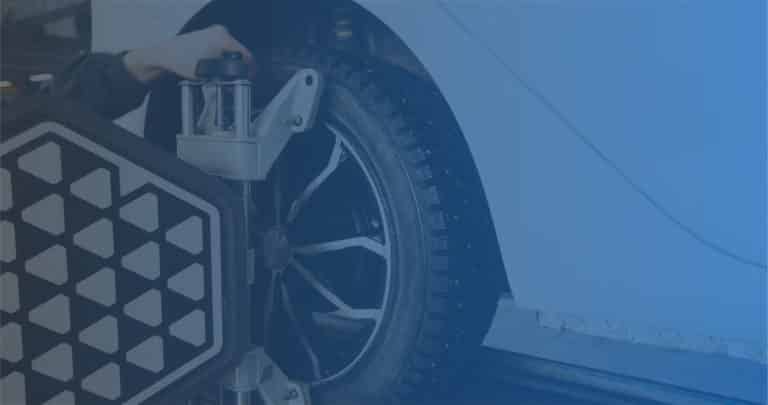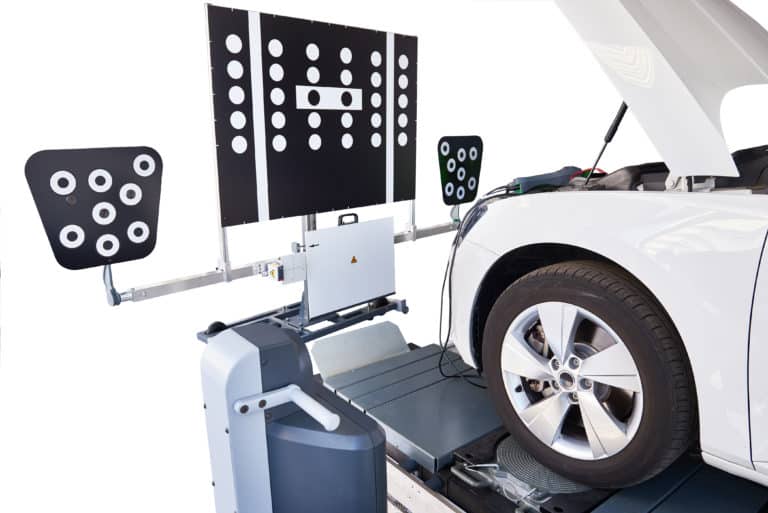If you have been active in the advanced driver-assistance systems (ADAS) or automotive space, you’ve likely heard about Level 5 ADAS or Level 5 Autonomy. But what is it actually, and how will it impact the auto industry? In this post, we’ll break down Level 5, showing how it fits into the broader Society of Automotive Engineers (SAE) automation scale and how it differs from the ADAS features most of us see on the road now. You’ll get a clear view of what systems are involved (from cameras and radar to lidar and software), why precise calibration matters, and how shops can adapt processes to keep pace with rapidly evolving technology.
What is Level 5 ADAS?
Let’s start simple and build up. The SAE scale runs from Level 0 (no automation) to Level 5 (full automation). Level 5 ADAS means a vehicle can drive itself anywhere a human could drive, in any weather or traffic condition, without needing a human to step in, ever. No geofences, no “only on highways,” no “only when the sun is out.” The automated driving system (ADS) handles the entire driving task: seeing the world, interpreting what it sees, deciding what to do next, and carrying those decisions out smoothly and safely.
Here’s what that really includes:
- Sensing the world (Perception): Cameras read lane markings, traffic lights, and signs. Radar measures distance and relative speed in rain or fog. Lidar paints a 3D picture of the surroundings. Ultrasonic sensors help up close. Some systems add thermal cameras for night visibility. Together, they feed a constantly updated model of “what’s around us right now.”
- Reading intent (Prediction): It’s not enough to know there’s a cyclist; the system has to estimate where that cyclist will be in the next second, two seconds, and five seconds, especially when the view is partially blocked or the lighting is harsh.
- Choosing actions (Planning): The ADAS weighs options in real time—merge now or wait, brake gently or firmly, reroute around a construction zone, negotiate with a double-parked truck, and so on—aiming for safety, legality, and passenger comfort.
- Executing smoothly (Control): Steering, acceleration, and braking must feel natural while respecting traction limits, road grade, and surface conditions.
How Level 5 ADAS Differs from Level 4 and Lower Levels
Before we talk timelines, it helps to use the same vocabulary the industry and regulators use:
- Levels 0–2 (Driver Assistance): The vehicle provides assistance and includes features like adaptive cruise control, automatic emergency braking, and lane-centering assist. However, a human must watch the road and be ready to act at all times.
- Level 3 (Conditional Automation): The system can drive under specific conditions, but it may ask a human to take over. Think: traffic-jam autopilot on certain highways.
- Level 4 (High Automation): The system drives without a human fallback, but only within its operational design domain (ODD). That ODD might be a limited set of city streets, a particular weather envelope, and defined speed ranges. If conditions exceed those limits, the vehicle must bring itself to a safe stop.
- Level 5 (Full Automation): There are no ODD limits that are narrower than what a human could handle. This includes urban canyons, rural backroads, snowstorms, work zones and unfamiliar detours. The vehicle system is responsible, full stop.
The jump from Level 4 to Level 5 is larger than it looks on paper. Level 4 can avoid edge cases by narrowing the domain: a sunny metro area, mapped in detail, with operating rules tuned to local conditions. Level 5 doesn’t get to choose; it has to be good everywhere. That means better perception in bad weather, stronger prediction in chaotic environments, planning that gracefully handles rare surprises, and a safety case that convinces regulators the vehicle will behave responsibly when patterns break.
How Close Are We to Level 5 ADAS
Now to the question everyone asks: “Are we almost there?”
Short version: We’re seeing real Level 4 services in limited domains and steady progress in hardware, software, and safety methods. But Level 5 for general consumer use isn’t here yet. To understand why, it helps to look at what the leading players are doing and what those efforts mean.
Waymo (Alphabet)
Waymo is widely viewed as the current frontrunner in Level 4 robotaxis. It operates fully driverless ride-hailing in select zones of U.S. cities like Phoenix, San Francisco, and Los Angeles. These aren’t demos; they’re live, paying services with growing footprints. The approach blends high-fidelity mapping, multi-sensor perception (cameras, radar, lidar), and conservative driving policies that favor predictability.
Cruise (GM)
Cruise rolled out robotaxi services in a few U.S. cities, then pulled back after safety incidents and regulatory action in late 2023. In 2024–2025, it has been working through a cautious return with safety drivers and staged re-entry. The big lesson isn’t that autonomy “doesn’t work,” it’s that public trust and governance are non-negotiable. Transparency about incidents, clear safety metrics, and verifiable improvements are now table stakes for expanding service footprints. This has indirectly strengthened the industry by sharpening safety and oversight practices.
Tesla
Despite the name “Full Self-Driving,” Tesla’s system is considered Level 2 today because it requires continuous driver supervision. Tesla’s advantage is scale: a massive fleet feeding back data and pushing frequent software updates. That scale can accelerate learning on common and medium-rare scenarios. But moving from “supervised Level 2 in many places” to “unsupervised Level 4/5 anywhere” is not just a data problem; it’s a responsibility and assurance problem. The system must prove it can operate without a human safety net, meet regulatory expectations, and handle long-tail edge cases consistently.
As for the timeline, Level 5 autonomy remains a distant goal. Predictions vary, but many experts believe it could be decades before fully autonomous vehicles that can handle any situation without human intervention become a mainstream reality.
As technology continues to evolve, these advancements pave the way for a future where at least Level 4 autonomy becomes integrated into everyday life. However, reaching this level of sophistication requires not only technical innovation but also addressing societal concerns, ethical considerations, and establishing trust among users.
Legal and Societal Impact of Level 5 ADAS
Even before Level 5 arrives, you can already see the ripple effects. Regulators are refining permit systems for testing and deployment. Cities are updating rules about curb space, pickup zones, and how autonomous vehicles interact with first responders. Insurance conversations are shifting from “What did the driver do?” to “What did the system know, when did it know it, and how did it respond?” That means data logs, software versions, and event records become central artifacts in claims, investigations, and recalls.
There’s also a culture shift around language. Using the SAE levels consistently, distinguishing driver assistance (L0–L2) from automated driving (L3–L5), helps set expectations for safety and responsibility. It reduces misunderstandings, clarifies coverage in policies and warranties, and guides owners in how to use the technology day to day. As autonomy scales, expect more public dashboards, reporting requirements, and standardized incident taxonomies so communities can track performance and hold systems accountable.
What Will Calibration Look Like for Level 5 ADAS?
Zooming ahead to an L5 world, support and service would mirror the system’s complexity, while aiming to feel simple for the end user. Expect tighter environmental controls for any work that affects sensors, glass, or body geometry; cross-sensor alignment checks that verify cameras, radar, and lidar agree on where things are; and scenario-based validations that replicate tricky real-world scenes (nighttime pedestrians, occlusions near intersections, odd road markings).
Software will be part of routine service in a much bigger way. Secure updates, version tracking, cryptographic attestation, and detailed logs will matter because autonomy is as much code and data as it is hardware. Clear, portable records will help everyone—owners, insurers, and regulators—understand what was changed and why, and confirm that the system still meets its intended performance after any repair or update.
In short, the service layer becomes more evidence-oriented and fusion-aware, with simple customer experiences riding on top of sophisticated quality controls behind the scenes.
If you own or plan to own a calibration center, you can prepare by investing in tools and infrastructure that facilitate the seamless management of data and calibration processes. This includes software designed for detailed logging of system updates, repair histories, and calibration records. Additionally, training your team to adopt these evidence-based practices will result in smoother operations and greater trust among customers and partners. Building a robust, transparent service model positions your calibration center as a leader in this rapidly evolving ecosystem.
Start or Grow Your ADAS Sensor Calibration Center with Car ADAS
Level 5 ADAS will not replace the fundamentals for calibration; it will amplify them. Precise measurements, controlled environments, OEM procedures, secure software access, airtight documentation, and disciplined quality control (QC) will be more essential than ever. If you’re ready to take the next step, we can help you shortcut the learning curve. At Car ADAS Solutions, we team up with businesses to build and scale calibration operations end-to-end through a turnkey program, guiding you from layout and environmental controls to compliant equipment selection, from technician upskilling to day-to-day workflow and documentation support. Whether you’re launching your first calibration bay or expanding to a dedicated center, we’ll help you stand up a repeatable, OEM-aligned operation that insurers trust and customers return to. Contact us today to learn more.







